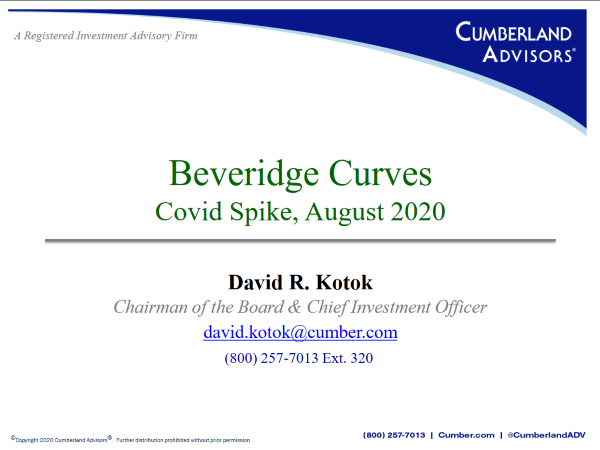We’ve prepared a series of Beveridge curve graphics so that readers can see the dramatic changes in the composition and direction of various labor-force-related measures. We are using a visual Beveridge curve approach. The charts (30 of them) are available from our website. Below is the link.
https://cumber.com/pdf/Beveridge-Curves-Covid-Aug-2020.pdf
The 30 charts are graphic and dramatic as they depict the largest economic “shock” since the Great Depression era. That said; we must caution readers, who spend time thinking about the chart series, that data is a problem and clarity is probably not possible until next year. Our friend Philippa Dunne and her colleagues publish the excellent TLR Analytics and illustrate the data problem with an example. We will quote from their August 20 report.
"Here is what data users need to know about proposed changes to Quarterly Census of Employment and Wages, QCEW, methodology. That’s the hard employment data, source of the benchmark.
"Usually about 95% of businesses respond to the QCEW survey. That rate fell in the first quarter and is expected to plummet in Q2. Currently, it’s not clear which businesses just didn’t get around to it, and which have closed their doors, and those empty cells are filled in with prior year activity for three quarters before being dropped, 'essentially pushing into the fourth quarter the declines that should have happened in the first,' in the words of one QCEW statistician.
"Importantly, many small businesses never report they have closed their doors, they just stop responding. State Department of Labor offices follow up with larger businesses who don’t respond in the current quarter, but to get a real-time read on what is happening with small businesses, QCEW statisticians will be using UI records for the individual non-responders to determine if they are still in business.
"Additionally, when QCEW employees cannot ascertain the state of the nonresponding business, they will fill in the cell using current responses from similar businesses instead of using year-old data. This will give us much more accurate, if grim, data going forward, and will cascade through personal income and other series that revise using QCEW data."
We thank TLR for this insightful nugget.
Please enjoy the Beveridge Curve series.
(Hat tip to my colleague Tom Patterson for his assistance with the presentation graphics.)
Click image or this link to open PDF Slidedeck.
David R. Kotok
Chairman of the Board & Chief Investment Officer
Email | Bio
Links to other websites or electronic media controlled or offered by Third-Parties (non-affiliates of Cumberland Advisors) are provided only as a reference and courtesy to our users. Cumberland Advisors has no control over such websites, does not recommend or endorse any opinions, ideas, products, information, or content of such sites, and makes no warranties as to the accuracy, completeness, reliability or suitability of their content. Cumberland Advisors hereby disclaims liability for any information, materials, products or services posted or offered at any of the Third-Party websites. The Third-Party may have a privacy and/or security policy different from that of Cumberland Advisors. Therefore, please refer to the specific privacy and security policies of the Third-Party when accessing their websites. Sign up for our FREE Cumberland Market Commentaries Cumberland Advisors Market Commentaries offer insights and analysis on upcoming, important economic issues that potentially impact global financial markets. Our team shares their thinking on global economic developments, market news and other factors that often influence investment opportunities and strategies.


